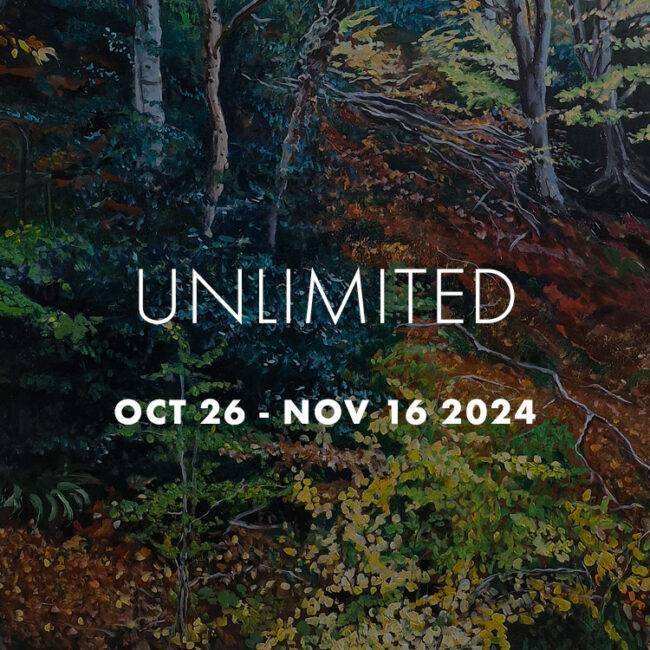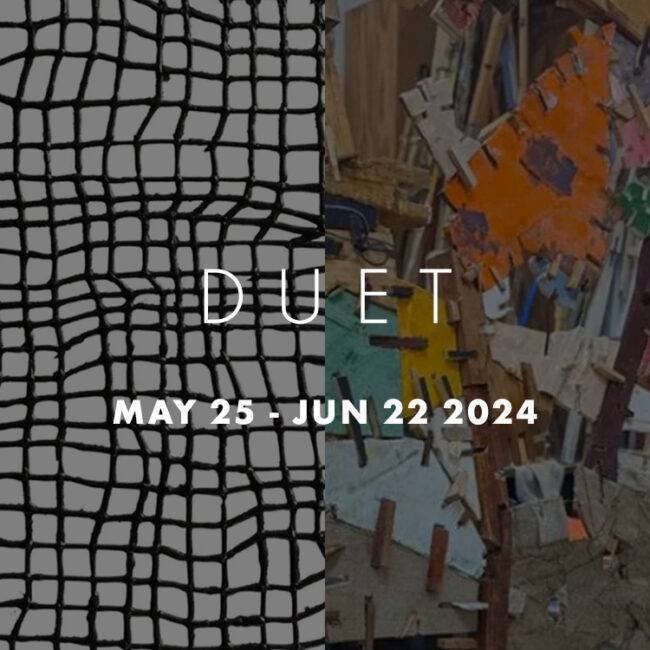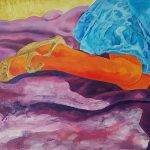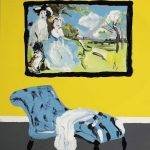September Group Show
September Group Show
SEP 29 – OCT 13 2018
Artists: Donald Teskey, Emma Straude, Jennifer Cunningham, Martin Gale, Michael Wann, Neil Grieg, Robert Ryan
Thoughts on Landscape Here and Now
By Sara Foust
The road up to Claremorris from Liscannor flashes by the windows and with every mile, we inhabit this landscape of blurred hedgerow, jet contrails in the sunset sky, the road ahead and that odd flyover that is so like an alpine tunnel. And on into the town of Claremorris, hunched together and bustling in the evening streetlamp glow, cones of misty light forming a row down the street. Gallery! Gallery! The neon announces.
The Claremorris Gallery launched its September Group Show on Saturday and we drove up from Clare. And here, after the drive through the landscape we found the landscape again, reinvented, rediscovered, reclaimed. This ‘landscape painting’ is a funny animal… 500 years ago it would have been all background, filled in by the student apprentices. Now it is the focus of our gaze, and we have our attention forcibly drawn up or down, to the surface or deep into the distance. Landscape painting is having something of its own renaissance in the Ireland of the moment, and it is tasty, sophisticated stuff. It is about paint and mark-making, about the hand of the artist and the heart of the place… and very deeply about the viewer’s point of view.
Immediately upon entering the gallery, Emma Stroude’s piece ‘Safe as Houses’ commands my attention. Emma’s sky-paintings force your eyes upward to interpret the marks we humans make even on the pristine canopy above. In this work there is an ominous black trail of smoke from what… a crash, some kind of terrible fire, what is burning? Are we safe? Yes, we are, there is such distance. There is the audience coming to the fore again; we are safely far away and yet compelled by worry or curiosity to continue to seek the point of origin.

With a bit of a turn, I find a little treasure of a painting by Kaye Maahs, hidden from view as you enter. Kaye’s work is rich with paint, yet economical. She doesn’t flatter the viewer with the importance of your gaze. You are small in her landscape, yet utterly privileged to be there. This monumental cloud dwarfs our sea and land, it sits heavy in form but still light in tones of soft pink and barely blued-grey, ‘Cumulus I’.
There is a gem in the corner. I am trying to ignore it, to work my way to it gradually, giving each piece its turn, but I am weak in resolve. In the end I am drawn to this painting, dark but glowing with delicious blue and red. It is Rose Stapleton’s ‘Camel Pavilion II, Booterstown’. The circus tent is clear and yet fading away, painted in glorious colour, sometimes with taut economies and then generosities that challenge the viewer to follow the artist into the scene—yet not into the tent. This is not a circus viewed by a child, but in this darkening light with honesty and a little distaste. Perhaps it is our job to pack this all away into lorries and move on.
There is a tree before me, nearly blocking the way. Michael Wann’s epic tree, drawn in charcoal with exactitude and kindness. He has caught this place at a moment, a season, with a profusion of marks yet a kind of Spartan restraint. Without colour we find nothing is lost, indeed there is a clarity to the light here. I would know that tree, that place anywhere. I am seeing it with deep knowledge, with the photomemory of a child’s eye.
I am primed for the Martin Gale (‘Behind Ballycastle Beach’) around the corner, my mind’s eye full of images from his recent show at the Taylor Gallery. This lovely small work feels different, the muddy tracks into the field somewhat softer, the detail of the post and the faded hedgerows somehow tinged with sweet melancholy. There is an October feeling to this little painting (or maybe it is just me feeling the rainy sweep against the window). I feel a sympathy for myself standing in this field, looking at the marks from the machinery of harvest, a small bittersweet sense of loss.
That feeling of loss doesn’t last long in the tumultuous joy of the back gallery. There is an embarrassment of riches here in paint and print, large and small. Neal Grieg’s ‘Kilvey Lake’ is alive with marks, the energy and movement of the understory. Gorgeous green moss on a tree trunk and the crystal shine of the lake through trees and brush, the viewer has slogged through the mud to gain this spot, it is glorious.
And then it snowed! Not Saturday night, of course, not in Claremorris… but in a series of paintings by Kaye Maahs on the back wall. This landscape that we know, under the unfamiliar blanket of snow and ice, transformed into contrasts—that inky black rath on the ridge, with its line of trees, and the flat grey light of the snow skies, sometimes tinged with green, sometimes a hint of pink. There is a play here with forms and mass, with an unnerving light and a tender palette. And there is a story told, once again with the landscape as the hero and we—as observers—are only incidental.
I turned then, and found Donald Teskey’s two small works ‘Blue Roof’ and ‘Anahalla Lee Valley’. You couldn’t mistake this land for anywhere else. You have walked down a mucky boreen and knocking the heads off a nettle with a switch, you turn a corner and you are there, at the old house. We have come to it at an oblique angle and the forestry casts a shadow at the back, but the gable end has caught the light and that is how we come up to it. The scumbled surface of the painting and the vigorous marks of gate and fencepost are sure and confident. We feel the solidity of the house and the years of growth in the woodland, and undoubtedly the strength of the artist’s marks, the scrape and surface and line. He places us squarely at home.
And from looking in and down, suddenly we are looking out and up—with a whoosh! we encounter Emma Stroude’s two paintings of urban skies, with celestial blue and cloud and trees silhouetted against the light, crossed by posts and wires and streetlamps. Emma leaves the land to force our eyes skyward, we are landed in our peripheral vision, in the movement of passing through, in the composition of divided skies.
Within the show there are works that serve as counterpoint, that change the questions others raise about landscape. Jennifer Cunningham’s work sits differently with the viewer. Here we have an inhabited landscape and an averted gaze, an emotional landscape of memory. Jennifer’s prints and paintings carry remnants of built structures, incorporated into the image like subconscious memories of industrial landscape. Her etchings are beautiful and haunting.
Anne Donnelly’s landscapes and avian paintings bring the viewer to the surface to consider method and texture. There is a difference to the light in her works that sets them apart within the gallery.
On the last wall, there is Robert Ryan, a series of uncanny paintings of surreal fox/sheep cavorting on continental hillsides. I am carried away from here, but not to any real place, more to a fantasy of a landscape, an historical reference to idyllic pastures. Robert’s paintings stand out as internal, surreal landscapes with personal meanings hidden from the viewer. We are standing high on the mountain to look across vast fields, searching for meaning in the narrative below.
And with a blast of wind, we are out into the night. The streetlamps are still casting cones of light into the mist, and the car is warm and alive with the radio carrying us home across the dark hills. The fields are hidden except for the flashes of outdoor lights and car headlights in the distance. There is a bit of light at the edge of the sky, fading to a dark Prussian blue and a distant home. Later, flashes on the dark wall of my mind that return to images of a scumbled gable wall, the ridge-line of a circus tent, and skies and smoke and trees and clouds, looking up and looking in.


